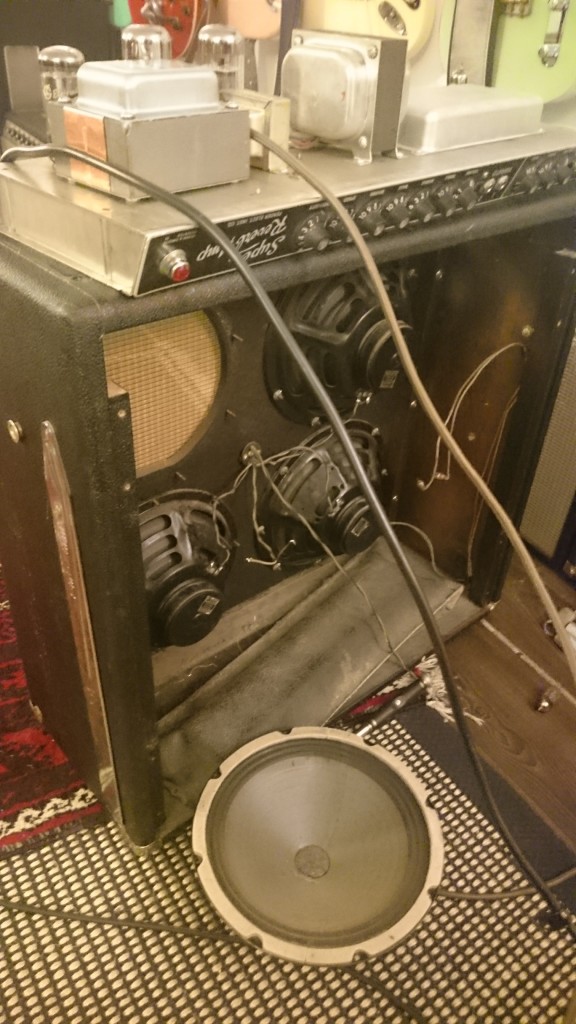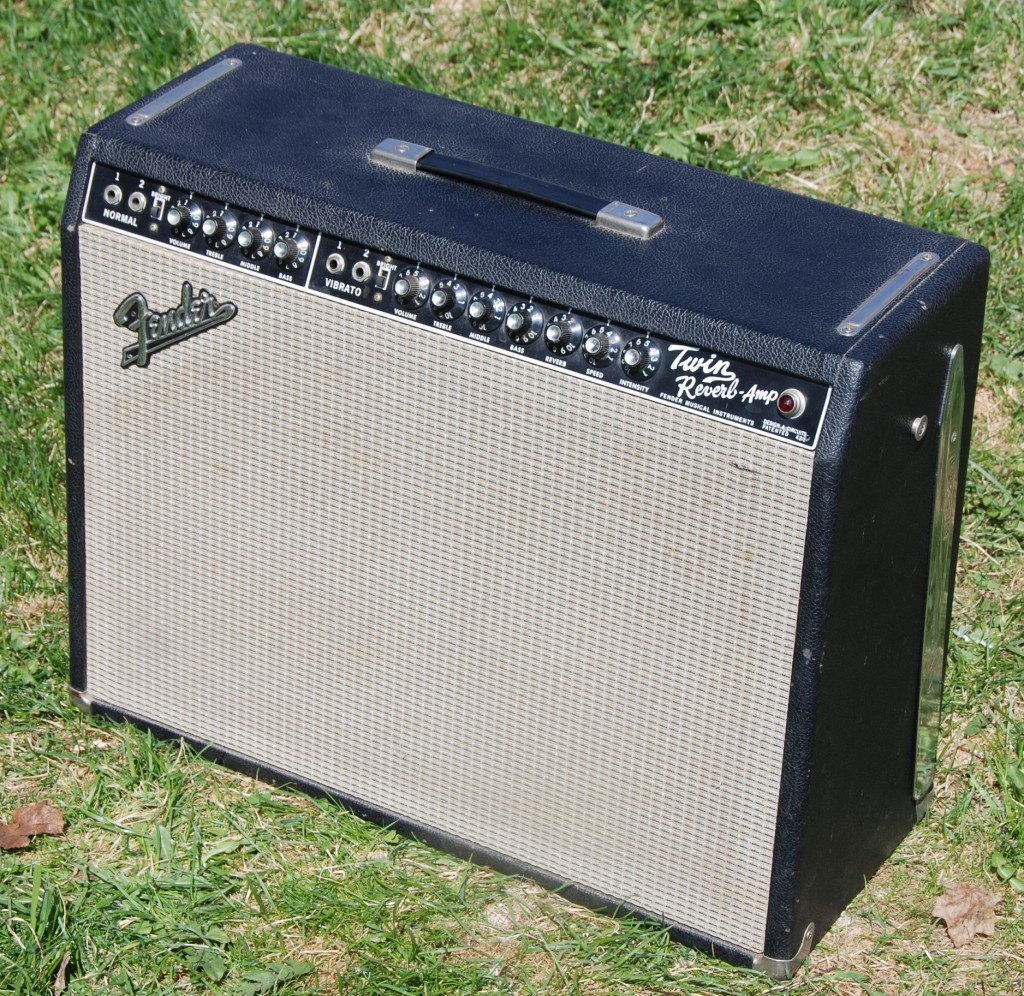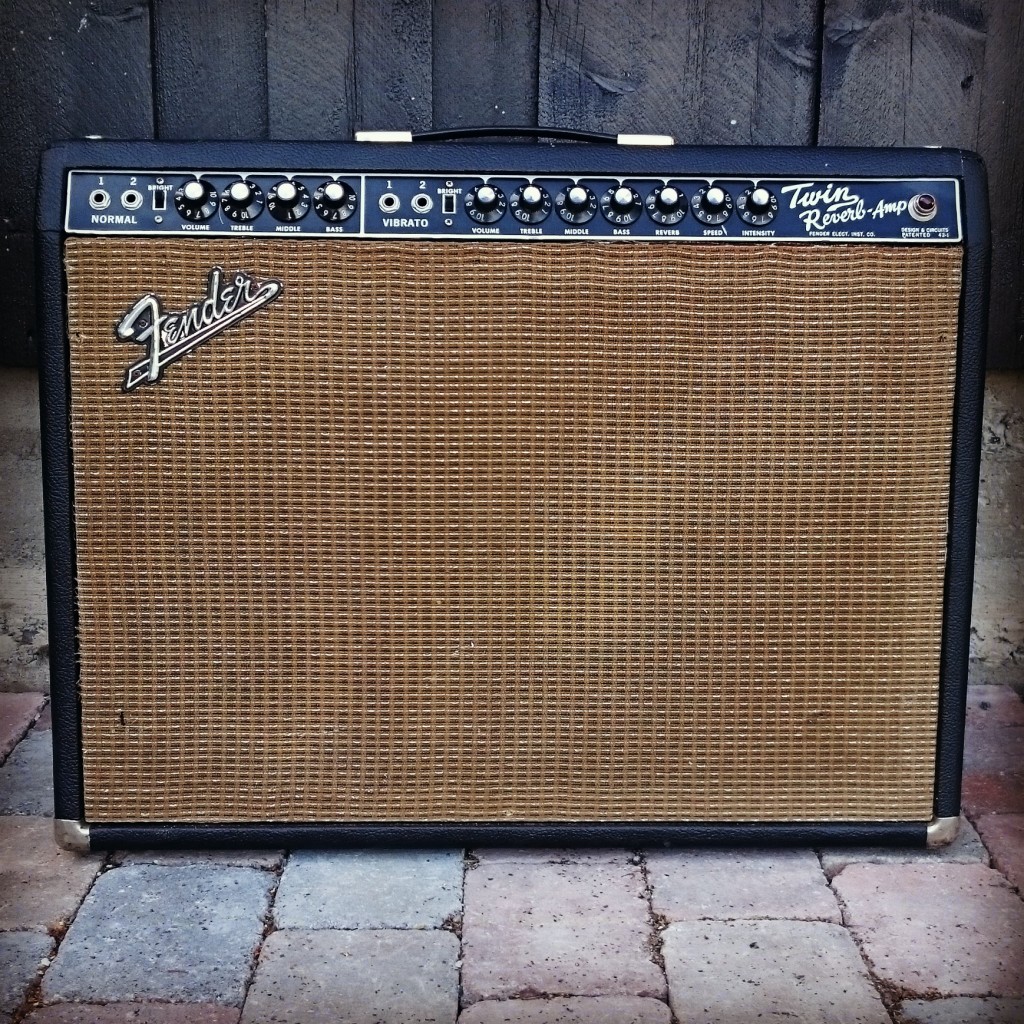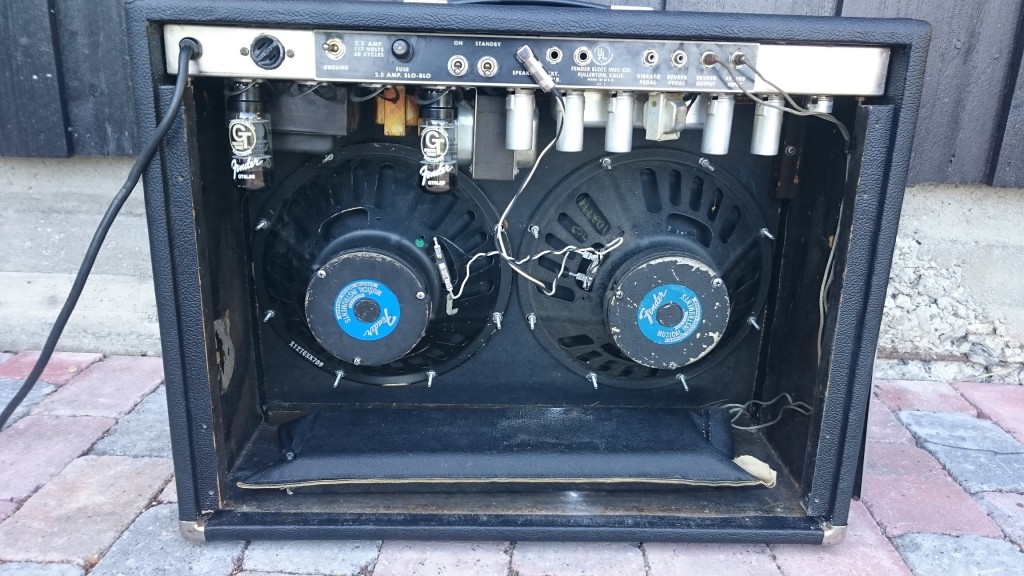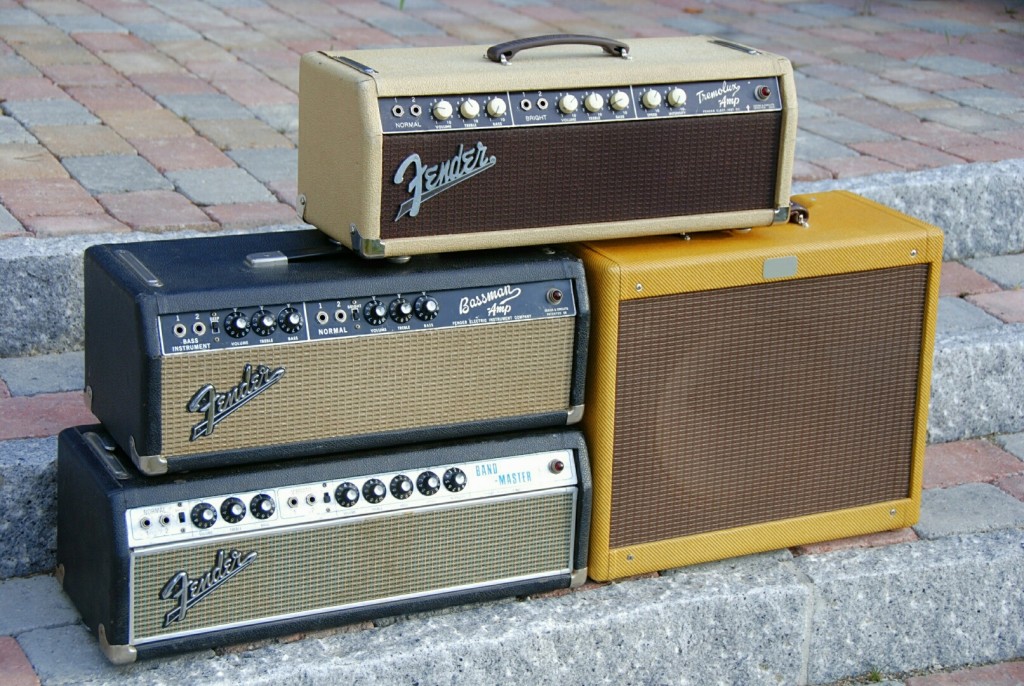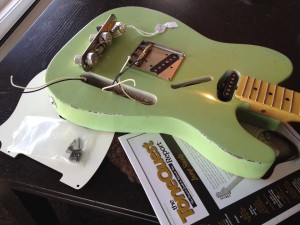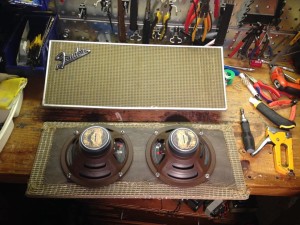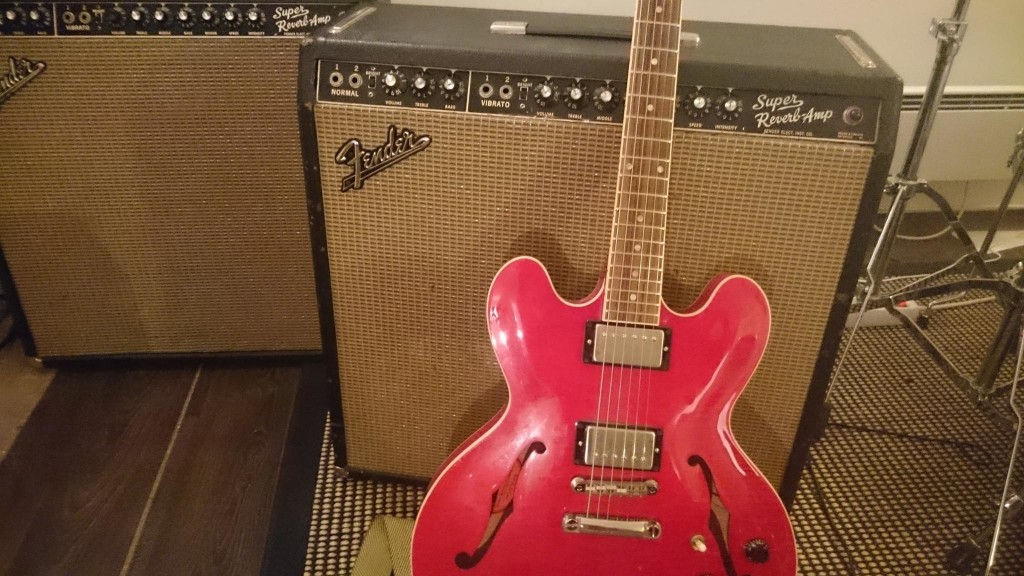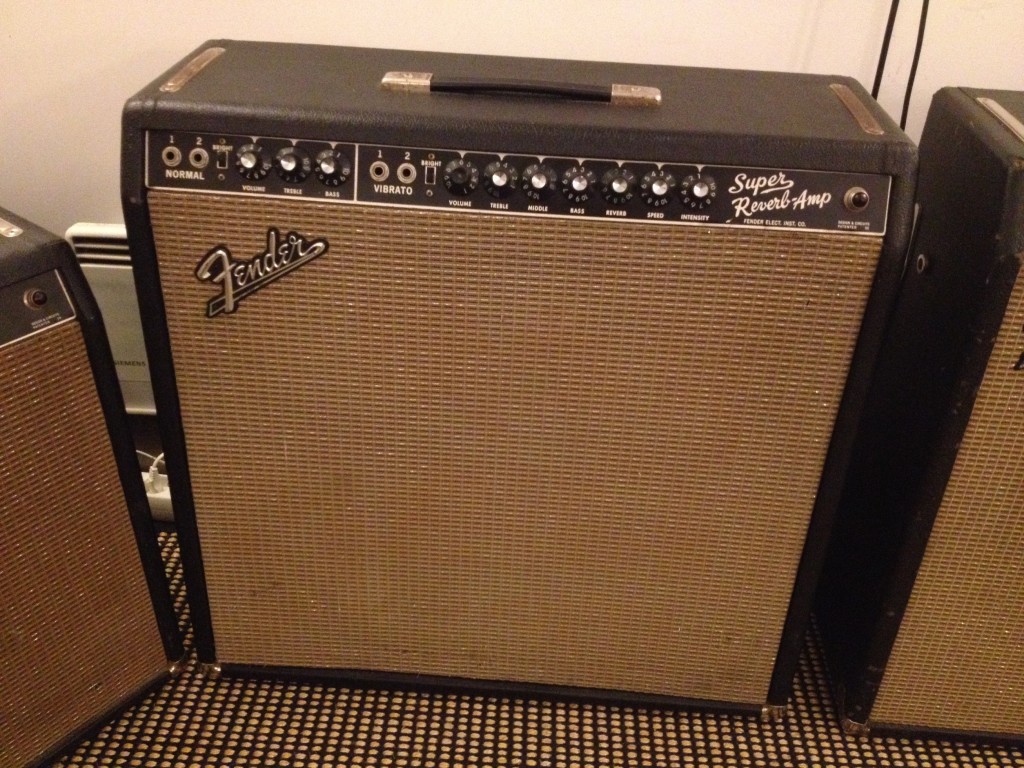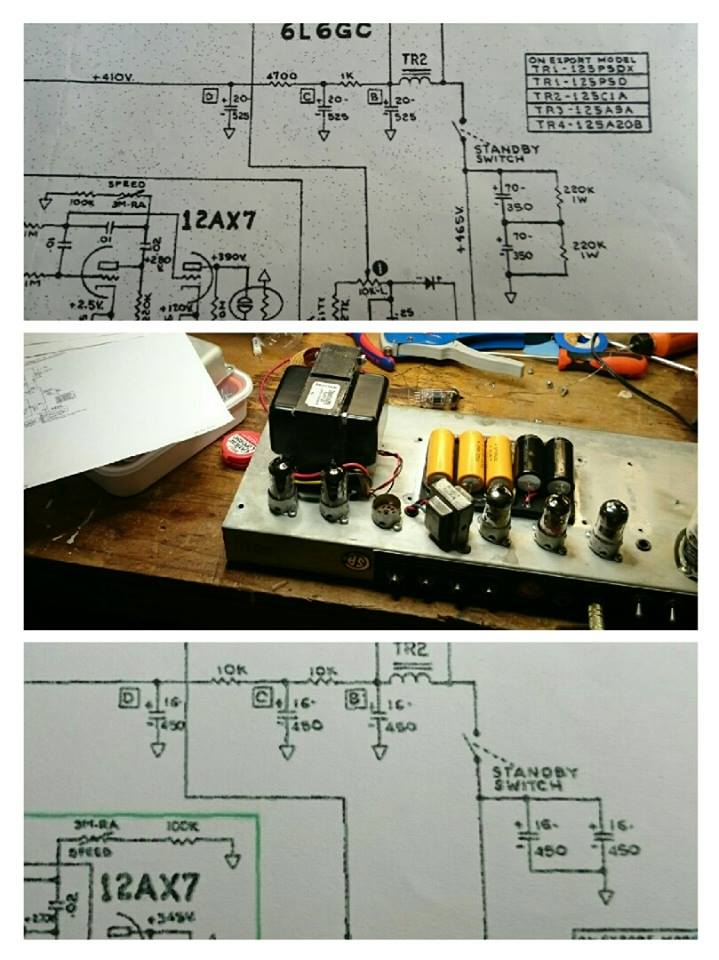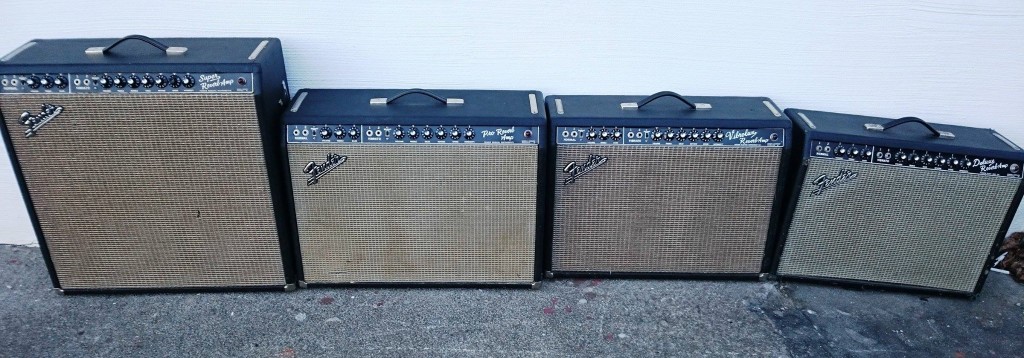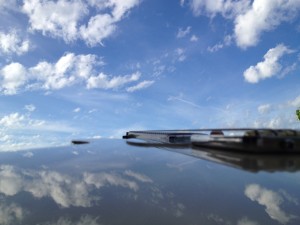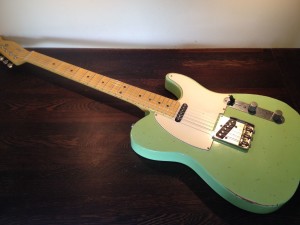We are hereby sharing with you an interview with the founder of fenderguru.com, Jens Mosbergvik. He talks about a few Fender amps that has been important to him and what he has learned during the years as a guitar player and tech.
fenderguru.com: What was your first Fender amp?
Jens: My first amp ever was a 25w solid state Fender Sidekick Reverb from 1983 with a blue-labeled 10” speaker. My parents bought it in Denmark street in London in 1983 together with a 1980 Japanese stratocaster which was my first guitar, not a very good one. The Sidekick reverb amp had gain, master volume and reverb. It sounded very boxy and small and a few years later, in the late 80’s, I bought a Marshall Valvestate 2x40w stereo 2×12” for my own money. My twin brother had the 1×80 watt version and we played licks from Eric Clapton, Gary Moore and Jeff Healey in our basement. Then I was into Stevie Ray Vaughan and realized I had to get a vintage Fender amp. The first amp was a blackface Super Reverb, a pre-CBS AB763 model labeled Fender Electrical Instruments and dated Jan 1965. It was purchased at Tre45 in Trondheim, Norway while I was studying electronics and telecommunications at the Norwegian University of Science and Technology. It set me back 14.000NOK (2333$) in 1996 including an external step-down transformer.

It looked terrible with a rough tolex with many cigarette burn marks and a grill cloth with so many tears you could see the speaker cones vibrating. The baffle was not very robust and both the baffle-cabinet screws and the speaker mounting screws were loose. The speakers were four non-original MojoTone 10RR from the early nineties that was loud, punchy and with a smooth treble. The amp was heavy, powerful, loud and with enough bass and lower mids to play smaller, unmiked gigs with a smooth clean sound.
fenderguru.com: Can you describe the tone of that Super Reverb?
Jens: It was clearly a player’s amp, not collector item. After it got new tubes and new electrolytic caps it was almost twice as loud as my brother’s 68 transition Super Reverb AB763 with original CTS Alnico speakers. My Super Reverb growled like a bear even with my thin sounding Olympic white 1995 US-made Stratocaster, which was my primary guitar at the time. This was before I knew how to get a decent tone out of a strat, which had a thin, flat sound with little sustain. The dark and mellow sounding amp paired very well with it. I had a cheap Boss OD3 pedal, which had some hizz and upper treble that came out very well in this amp. The amp actually sounded so good that my brother eventually sold his 68 Super Reverb and bought a custom shop 64 Diaz Vibroverb looking for a louder SRV tone. We learned later that the speakers was the reason our Super Reverbs sounded so differently. When we were twenty years old and played SRV-stuff all day long, volume and punch mattered more than anything did. Since I studied electrical engineering, I was curious to study the circuits of the Super Reverb. I opened it and was deeply surprised how simple it was, much simpler than the circuits we learned about at the university. It was just wires, caps, resistors and some tubes. Once we learned at school how to study AC and DC signals separately in circuits, it was not difficult to start service and experimenting with these amps on my own. I still have the blackface 1965 Super Reverb today. A few years ago, I replaced the grill cloth with a nicer one from a 1966 Super Reverb. I also installed period-correct CTS Ceramic speakers to get a vintage correct tone instead of the raunchy, rock’n roll Mojotone speakers. The CTS Ceramics are also loud speakers, louder than the Alnicos.
Jens: I have often lend out my first Super Reverb to professional musicians and the response is always thumbs up. Some of my closest friends also nod their head when they hear this amp live. The tone is big, round and full, yet simple, natural and direct. What you hear is the guitar and fingers and I think it actually sounds and feels better on stage among the band members than in a room through a PA. Touch sensitive vintage style speakers through a clean amp will reveal all your mistakes, but that is how you become a better guitar player. The blackface and silverface Super Reverb are hard to beat, even for modern amps. Yes, there are sometimes scratchy pots and microphonic tubes, but everyone struggles with that in all amps no matter when they are made and of what materials. During the years, I have often reduced the headroom in Super Reverbs when playing on medium/smaller stages. The 12ax7 phase inverter and pull V1 is a must-have tube mod for me. I also think that YelloyJackets EL84 sound nice, almost like 6L6 but with a 20-25w headroom.
fenderguru.com: You have probably owned and played a few hundred Fender amps during the years. Is there anyone particular that you would mention to our readers?
Jens: In the last twenty years there are just two amps that I regret selling, both very nice looking and with a tone to die for. One is a 1976 silverface Princeton Reverb that I experimented a lot with after reading on forums that many people modified them to sound bigger, better and louder.
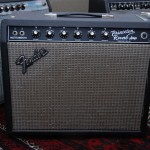 Back then, I believed more of what I read on the Internet than I do now and I did not reflect that much on why people modified their amps to sound different. I got the impression that almost everyone installed a 12″ speaker, did the Stokes and Paul C mod and replaced the output transformer with a bigger one from a Deluxe. And so did I. But as my amp collection grew with the years with smaller and bigger amps, I started appreciating the Princeton Reverb more for the light 10″, 12w combos they are, perfectly suited for practice and smaller stages. However, if you own just one amp, a Princeton Reverb, it is understandable that someone wants more from it. Anyways, my 76 Princeton Reverb soon got a new solid pine baffle cut for a 12” Jensen C12n speaker, a newer Italian reissue that sounded strong, full and bright with a much deeper bass response than the original Oxford 10j4.
Back then, I believed more of what I read on the Internet than I do now and I did not reflect that much on why people modified their amps to sound different. I got the impression that almost everyone installed a 12″ speaker, did the Stokes and Paul C mod and replaced the output transformer with a bigger one from a Deluxe. And so did I. But as my amp collection grew with the years with smaller and bigger amps, I started appreciating the Princeton Reverb more for the light 10″, 12w combos they are, perfectly suited for practice and smaller stages. However, if you own just one amp, a Princeton Reverb, it is understandable that someone wants more from it. Anyways, my 76 Princeton Reverb soon got a new solid pine baffle cut for a 12” Jensen C12n speaker, a newer Italian reissue that sounded strong, full and bright with a much deeper bass response than the original Oxford 10j4.
fenderguru.com: Can you describe the tone of that Princeton Reverb?
Jens: If someone is looking for a quacky strat tone with the in-between pickup positions (think Robert Cray, early Mark Knopfler), the Jensen C12n is a winner in the PR. I also implemented the Stokes mod and Paul C to get more clean headroom and a smoother distortion without noticing as much change as I hoped. What mattered most next to a 12″ speaker was the bigger Deluxe output transformer and a 25K mid pot installed in the back where the ground switch used to be. When cranked, this amp was enormously loud. I also changed a resistor in the tremolo circuit to get a deeper tremolo effect, a common thing to do in silverface Princeton Reverbs. A colder 6V6 bias will also increase the tremolo effect because of how the bias-based tremolo works. This hot-rodded Princeton Reverb with a mid control was a hybrid between a Princeton Reverb, Deluxe Reverb and a 18w british vox/marshall combo, and the Jensen C12n in an open cabinet always ensured a flavor of the pure American Fender tone.
 The clean sound with a strat was incredible; almost as good as a 6L6 Deluxe Reverb with EVM12L, but what the PR really excelled in was a telecaster in bridge pickup position with the mids turned all the way up on the amp. You could play Stones and AC/DC with just the guitar and amp. Many players and musicians I have met were impressed by the tone of this small amp. I also installed a pre-CBS black faceplate. When there was nothing more experiments to do, I eventually sold it to a guy who paid well enough for it. I don’t remember exactly how much that was, maybe 12.000NOK (2000$). One year after I regretted and got myself another Princeton Reverb, this time a 66 blackface Princeton Reverb with an original Jensen C10n that sounded so well I could not believe it was possible. It did not need any modifications at all. The Jensen C10n speaker was just as good as its bigger brother C12n. A 10” is not as loud as a 12”, but it is long time since I realized that volume would not make me a better player. Since then I’ve also had several silverface Princeton Reverbs, all sounding different due to different speakers. Very few speakers are better than the Jensen C12n and C10n. The Celestion Greenback 10” is surprisingly good, though.
The clean sound with a strat was incredible; almost as good as a 6L6 Deluxe Reverb with EVM12L, but what the PR really excelled in was a telecaster in bridge pickup position with the mids turned all the way up on the amp. You could play Stones and AC/DC with just the guitar and amp. Many players and musicians I have met were impressed by the tone of this small amp. I also installed a pre-CBS black faceplate. When there was nothing more experiments to do, I eventually sold it to a guy who paid well enough for it. I don’t remember exactly how much that was, maybe 12.000NOK (2000$). One year after I regretted and got myself another Princeton Reverb, this time a 66 blackface Princeton Reverb with an original Jensen C10n that sounded so well I could not believe it was possible. It did not need any modifications at all. The Jensen C10n speaker was just as good as its bigger brother C12n. A 10” is not as loud as a 12”, but it is long time since I realized that volume would not make me a better player. Since then I’ve also had several silverface Princeton Reverbs, all sounding different due to different speakers. Very few speakers are better than the Jensen C12n and C10n. The Celestion Greenback 10” is surprisingly good, though.
fenderguru.com: What was the other amp you regretted letting go?
Jens: The second amp I regret selling was a pristine blackface 1966 Twin Reverb AB763 loaded with original Jensen C12n speakers. Man did this amp have a clean tone from heaven. I bought it a long time ago for approx. 1200$ on US eBay. I didn’t buy it because I needed a big amp for gigs or anything. I just wanted to learn what the legendary 85w quad 6L6 Twin Reverb was all about.
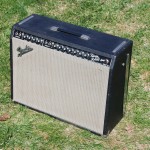 When I got this amp, I was not familiar with the Jensen C12n in these amps. After having played and serviced lot of amps, I think the American-made Jensen C12n are the best sounding speakers that ever came in any Fender amp. If you have a blackface Pro Reverb or Twin Reverb with Jensen C12n, hold on to it! There is no better tone using either factory-original or upgrade speakers, IMHO. It is pure vintage Fender with a slightly scooped EQ profile. They were robust too. It is a shame that the Deluxe Reverb never came out with Jensen C12n. Secondly, maybe it is a good thing. A Jensen C12n would have made the Deluxe Reverbs even more popular and harder to find than they already are. Next to the Jensen C12n, I think the Oxford 12T6 are great sounding speakers in Twin and Pro Reverb, much better than the other 12” Oxford, Eminence or Utah speakers. Back to the 66 Twin Reverb. I sold this amp quite suddenly when a customer came in my basement looking for an amp that could deliver a decent clean sound with his nr 1 guitar, a newer strat with Eric Clapton Lace sensor pickups. These pickups give a very strong signal. On top of that, they were adjusted close to the strings, which increases the signal strength even more. This specific guitar pushed the amp’s preamp sections so hard that he struggled finding an amp that did not distort even at medium volume. The customer was chasing a specific tone and not only did he bring his own jack cable, he even had his own power cable that lifted the ground and had several homemade magnetic rings surrounding the cable that removed noise. Whenever I touched the chassis of my amps he played in the basement, I got a 230V shock. He continued playing ten-fifteen amps including BF and SF Super Reverbs, new and old Vibroverbs, 60w Vibro-Kings with screaming Weber ceramic speakers, diode-rectified Bandmasters and Bassmans. He still was not satisfied. He then noticed the stellar blackface Twin Reverb standing in a different corner than the other amps who were for sale. I told him the Twin was not for sale but that he could try it. He turned on the amp and plugged in his guitar that was far out of tune, either because of bad intonation, magnetic pull from pickups, or simply out of tune. He played a simple D chord on the four last strings and after letting it ring for two seconds, he said, “I want it”. I seized the moment and told him that I could only let this amp go for a price that would get me another Twin Reverb with collector looks. Gladly he paid me 20.000NOK (approx. 3333$) for the amp. This was in 2011, I think. Sadly, I have not been able to locate a similar amp afterwards. Having that said, I have an equally nice 1966 Pro Reverb with Jensen C12n that brings the smile from me and anybody else that plays it. A slightly cranked Pro Reverb with Jensen C12n is one of the more beautiful Fender tones out there. Where the Twin Reverb stays evil clean above 4-5 on the volume knob, the Pro will gradually give you sag, compression and tube distortion. The small output transformer plays a significant role in all this. The Pro Reverb has more mids and more spread than the Super Reverb, and it’s not as loud and difficult to dial in a sweet tone. You can practically use any guitar with any pickups and get a decent tone.
When I got this amp, I was not familiar with the Jensen C12n in these amps. After having played and serviced lot of amps, I think the American-made Jensen C12n are the best sounding speakers that ever came in any Fender amp. If you have a blackface Pro Reverb or Twin Reverb with Jensen C12n, hold on to it! There is no better tone using either factory-original or upgrade speakers, IMHO. It is pure vintage Fender with a slightly scooped EQ profile. They were robust too. It is a shame that the Deluxe Reverb never came out with Jensen C12n. Secondly, maybe it is a good thing. A Jensen C12n would have made the Deluxe Reverbs even more popular and harder to find than they already are. Next to the Jensen C12n, I think the Oxford 12T6 are great sounding speakers in Twin and Pro Reverb, much better than the other 12” Oxford, Eminence or Utah speakers. Back to the 66 Twin Reverb. I sold this amp quite suddenly when a customer came in my basement looking for an amp that could deliver a decent clean sound with his nr 1 guitar, a newer strat with Eric Clapton Lace sensor pickups. These pickups give a very strong signal. On top of that, they were adjusted close to the strings, which increases the signal strength even more. This specific guitar pushed the amp’s preamp sections so hard that he struggled finding an amp that did not distort even at medium volume. The customer was chasing a specific tone and not only did he bring his own jack cable, he even had his own power cable that lifted the ground and had several homemade magnetic rings surrounding the cable that removed noise. Whenever I touched the chassis of my amps he played in the basement, I got a 230V shock. He continued playing ten-fifteen amps including BF and SF Super Reverbs, new and old Vibroverbs, 60w Vibro-Kings with screaming Weber ceramic speakers, diode-rectified Bandmasters and Bassmans. He still was not satisfied. He then noticed the stellar blackface Twin Reverb standing in a different corner than the other amps who were for sale. I told him the Twin was not for sale but that he could try it. He turned on the amp and plugged in his guitar that was far out of tune, either because of bad intonation, magnetic pull from pickups, or simply out of tune. He played a simple D chord on the four last strings and after letting it ring for two seconds, he said, “I want it”. I seized the moment and told him that I could only let this amp go for a price that would get me another Twin Reverb with collector looks. Gladly he paid me 20.000NOK (approx. 3333$) for the amp. This was in 2011, I think. Sadly, I have not been able to locate a similar amp afterwards. Having that said, I have an equally nice 1966 Pro Reverb with Jensen C12n that brings the smile from me and anybody else that plays it. A slightly cranked Pro Reverb with Jensen C12n is one of the more beautiful Fender tones out there. Where the Twin Reverb stays evil clean above 4-5 on the volume knob, the Pro will gradually give you sag, compression and tube distortion. The small output transformer plays a significant role in all this. The Pro Reverb has more mids and more spread than the Super Reverb, and it’s not as loud and difficult to dial in a sweet tone. You can practically use any guitar with any pickups and get a decent tone.
fenderguru.com: Which amps do you most often bring at gigs?
Jens: I think it is the “Linda Ronstadt” amp. It is a 68 Deluxe Reverb with 6L6 tubes and a vintage EVM 12L speaker. After I disabled the bright cap, the tone became liquid clear and not as sharp and trebly as it used to be.
 All Deluxe Reverb owners with bright speakers should disable the bright cap. The amp will handle pedals much better, in my opinion. The amp had initially a JBL d120f speaker that I replaced with an EVM 12L. The EVM 12L will take anything that is thrown at it. It even remains firm in the bottom over volume 6 and all the way up. Together with a strat in neck pickup it is magical, a mini-blackface Vibroverb. The clean tone with a strat is just superior to any other amp and guitar I’ve played. And I am serious when it gets to clean sound, that is primarily how I judge an amp. My Deluxe Reverb gig amp also has quite a few mods, such as; tremolo disconnect with a switchable trem intensity pot, mid knob in the back and a pedal-switchable NBF loop that goes in where the reverb pedal used to be. I never disable the reverb using the pedal anyway. I have just lately invented this NBF switch mod, which for me eliminates the need of a boost pedal on my board. When engaged you get a slight increase of gain, volume and treble which is perfect for solos and leads. It doesn’t require battery or power supply and there is no fuzz about true bypass. It does not steal or change the signal at all. It’s just more vintage Fender breakup! Since the signal going through the pedal is hot, you need to insulate the phono plug on the back to prevent grounding the signal when the pedal is switched on.
All Deluxe Reverb owners with bright speakers should disable the bright cap. The amp will handle pedals much better, in my opinion. The amp had initially a JBL d120f speaker that I replaced with an EVM 12L. The EVM 12L will take anything that is thrown at it. It even remains firm in the bottom over volume 6 and all the way up. Together with a strat in neck pickup it is magical, a mini-blackface Vibroverb. The clean tone with a strat is just superior to any other amp and guitar I’ve played. And I am serious when it gets to clean sound, that is primarily how I judge an amp. My Deluxe Reverb gig amp also has quite a few mods, such as; tremolo disconnect with a switchable trem intensity pot, mid knob in the back and a pedal-switchable NBF loop that goes in where the reverb pedal used to be. I never disable the reverb using the pedal anyway. I have just lately invented this NBF switch mod, which for me eliminates the need of a boost pedal on my board. When engaged you get a slight increase of gain, volume and treble which is perfect for solos and leads. It doesn’t require battery or power supply and there is no fuzz about true bypass. It does not steal or change the signal at all. It’s just more vintage Fender breakup! Since the signal going through the pedal is hot, you need to insulate the phono plug on the back to prevent grounding the signal when the pedal is switched on.
fenderguru.com: What is your latest discoveries of amps?
Jens: A cool amp that I would like to play more at gigs is the blackface Bassman with a few mods to lower the headroom.
This amp is completely different from the other blackface and silverface amps since it distorts heavily at higher volumes. If you find the right speaker cabinet for this amp that are not very loud, you have a true rock’n roll amp with no pedals at all. Since there is no reverb, no tremolo and no speakers, nothing will ever break in these amps except the regular tube and pot wear. In 2050, I think the world will still see a huge amount of blackface and silverface Bassmans around on stages and clubs. It is not too late for you to get one of these.

